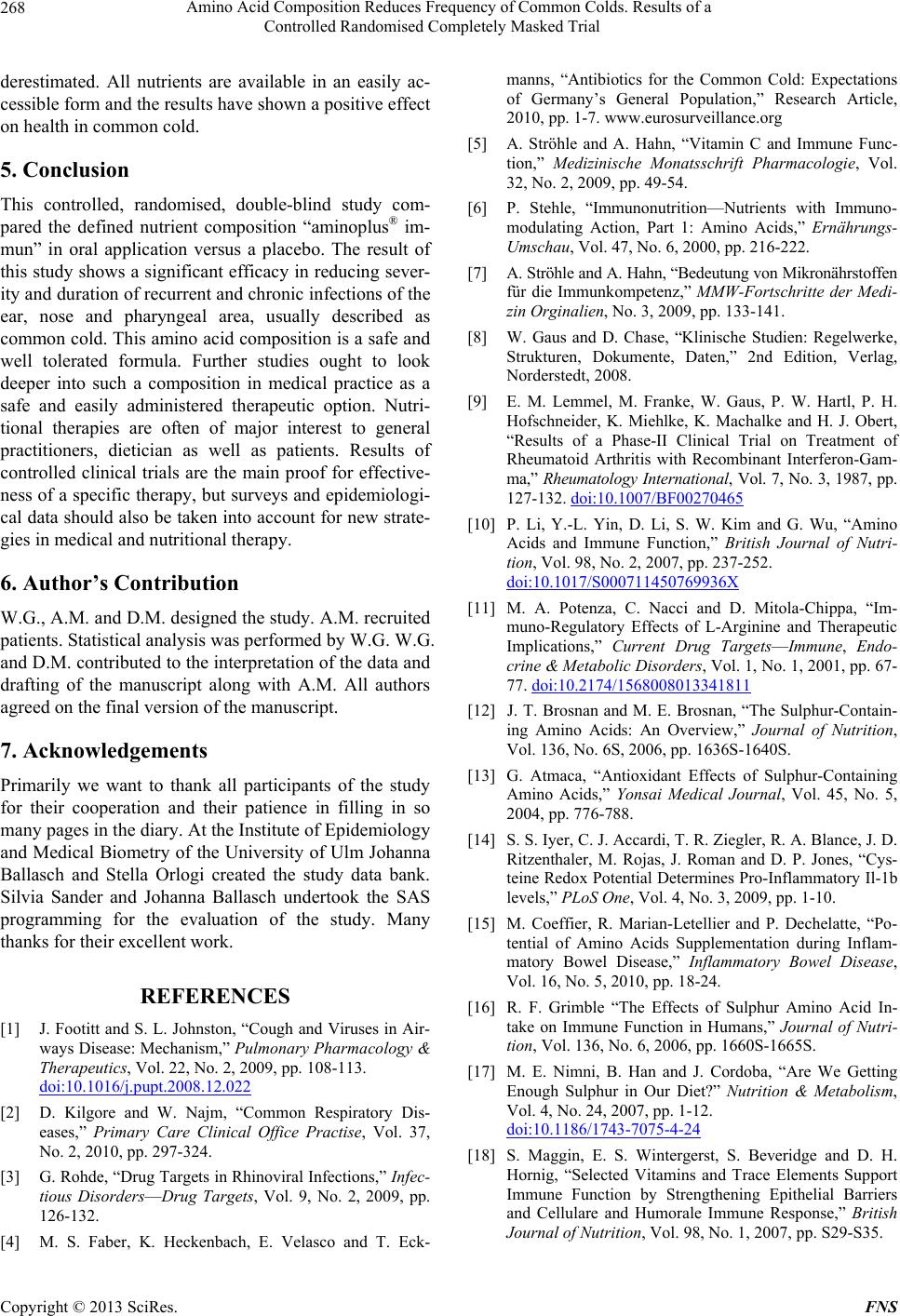
Amino Acid Composition Reduces Frequency of Common Colds. Results of a
Controlled Randomised Completely Masked Trial
268
derestimated. All nutrients are available in an easily ac-
cessible form and the results have shown a positive effect
on health in common cold.
5. Conclusion
This controlled, randomised, double-blind study com-
pared the defined nutrient composition “aminoplus® im-
mun” in oral application versus a placebo. The result of
this study shows a significant efficacy in reducing sever-
ity and duration of recurrent and chronic infections of the
ear, nose and pharyngeal area, usually described as
common cold. This amino acid composition is a safe and
well tolerated formula. Further studies ought to look
deeper into such a composition in medical practice as a
safe and easily administered therapeutic option. Nutri-
tional therapies are often of major interest to general
practitioners, dietician as well as patients. Results of
controlled clinical trials are the main proof for effective-
ness of a specific therapy, but surveys and epidemiologi-
cal data should also be taken into account for new strate-
gies in medical and nutritional therapy.
6. Author’s Contribution
W.G., A.M. and D.M. designed the study. A.M. recruited
patients. Statistical analysis was performed by W.G. W.G.
and D.M. contributed to the interpretation of the data and
drafting of the manuscript along with A.M. All authors
agreed on the final version of the manuscript.
7. Acknowledgements
Primarily we want to thank all participants of the study
for their cooperation and their patience in filling in so
many pages in the diary. At the Institute of Epidemiology
and Medical Biometry of the University of Ulm Johanna
Ballasch and Stella Orlogi created the study data bank.
Silvia Sander and Johanna Ballasch undertook the SAS
programming for the evaluation of the study. Many
thanks for their excellent work.
REFERENCES
[1] J. Footitt and S. L. Johnston, “Cough and Viruses in Air-
ways Disease: Mechanism,” Pulmonary Pharmacology &
Therapeutics, Vol. 22, No. 2, 2009, pp. 108-113.
doi:10.1016/j.pupt.2008.12.022
[2] D. Kilgore and W. Najm, “Common Respiratory Dis-
eases,” Primary Care Clinical Office Practise, Vol. 37,
No. 2, 2010, pp. 297-324.
[3] G. Rohde, “Drug Targets in Rhinoviral Infections,” Infec-
tious Disorders—Drug Targets, Vol. 9, No. 2, 2009, pp.
126-132.
[4] M. S. Faber, K. Heckenbach, E. Velasco and T. Eck-
manns, “Antibiotics for the Common Cold: Expectations
of Germany’s General Population,” Research Article,
2010, pp. 1-7. www.eurosurveillance.org
[5] A. Ströhle and A. Hahn, “Vitamin C and Immune Func-
tion,” Medizinische Monatsschrift Pharmacologie, Vol.
32, No. 2, 2009, pp. 49-54.
[6] P. Stehle, “Immunonutrition—Nutrients with Immuno-
modulating Action, Part 1: Amino Acids,” Ernährungs-
Umschau, Vol. 47, No. 6, 2000, pp. 216-222.
[7] A. Ströhle and A. Hahn, “Bedeutung von Mikronährstoffen
für die Immunkompetenz,” MMW-Fortschritte der Medi-
zin Orginalien, No. 3, 2009, pp. 133-141.
[8] W. Gaus and D. Chase, “Klinische Studien: Regelwerke,
Strukturen, Dokumente, Daten,” 2nd Edition, Verlag,
Norderstedt, 2008.
[9] E. M. Lemmel, M. Franke, W. Gaus, P. W. Hartl, P. H.
Hofschneider, K. Miehlke, K. Machalke and H. J. Obert,
“Results of a Phase-II Clinical Trial on Treatment of
Rheumatoid Arthritis with Recombinant Interferon-Gam-
ma,” Rheumatology International, Vol. 7, No. 3, 1987, pp.
127-132. doi:10.1007/BF00270465
[10] P. Li, Y.-L. Yin, D. Li, S. W. Kim and G. Wu, “Amino
Acids and Immune Function,” British Journal of Nutri-
tion, Vol. 98, No. 2, 2007, pp. 237-252.
doi:10.1017/S000711450769936X
[11] M. A. Potenza, C. Nacci and D. Mitola-Chippa, “Im-
muno-Regulatory Effects of L-Arginine and Therapeutic
Implications,” Current Drug Targets—Immune, Endo-
crine & Metabolic Disorders, Vol. 1, No. 1, 2001, pp. 67-
77. doi:10.2174/1568008013341811
[12] J. T. Brosnan and M. E. Brosnan, “The Sulphur-Contain-
ing Amino Acids: An Overview,” Journal of Nutrition,
Vol. 136, No. 6S, 2006, pp. 1636S-1640S.
[13] G. Atmaca, “Antioxidant Effects of Sulphur-Containing
Amino Acids,” Yonsai Medical Journal, Vol. 45, No. 5,
2004, pp. 776-788.
[14] S. S. Iyer, C. J. Accardi, T. R. Ziegler, R. A. Blance, J. D.
Ritzenthaler, M. Rojas, J. Roman and D. P. Jones, “Cys-
teine Redox Potential Determines Pro-Inflammatory Il-1b
levels,” PLoS One, Vol. 4, No. 3, 2009, pp. 1-10.
[15] M. Coeffier, R. Marian-Letellier and P. Dechelatte, “Po-
tential of Amino Acids Supplementation during Inflam-
matory Bowel Disease,” Inflammatory Bowel Disease,
Vol. 16, No. 5, 2010, pp. 18-24.
[16] R. F. Grimble “The Effects of Sulphur Amino Acid In-
take on Immune Function in Humans,” Journal of Nutri-
tion, Vol. 136, No. 6, 2006, pp. 1660S-1665S.
[17] M. E. Nimni, B. Han and J. Cordoba, “Are We Getting
Enough Sulphur in Our Diet?” Nutrition & Metabolism,
Vol. 4, No. 24, 2007, pp. 1-12.
doi:10.1186/1743-7075-4-24
[18] S. Maggin, E. S. Wintergerst, S. Beveridge and D. H.
Hornig, “Selected Vitamins and Trace Elements Support
Immune Function by Strengthening Epithelial Barriers
and Cellulare and Humorale Immune Response,” British
Journal of Nutrition, Vol. 98, No. 1, 2007, pp. S29-S35.
Copyright © 2013 SciRes. FNS